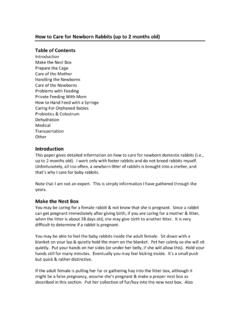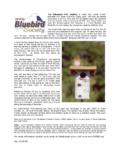Transcription of Wood duck nest box - Ducks Unlimited
1 Galvanized sheet metal Predator Guards rivet 18". 5 for 4 post 6 for 5 post for 6 post GALVANIZED. A predator guard will help to improve the chance of a successful hatch by preventing egg-eating Build a duck SHEET METAL. CONE raccoons from entering your nest box. All boxes should include Predator Guards! GALVANIZED SHEET METAL CONE. Nest Box This is the most effective predator deterrent. Cut a 36" diameter circle of ood Ducks , buffleheads, barrow's goldeneyes, common sheet metal. Cut an appropriately-sized hole in the middle to accomodate pole size. Remove an 8"slice from the circle, join the edges to form the cone, and rivet together. W goldeneyes, hooded mergansers and common mergansers are all cavity nesting Ducks . They build nests in STEEL SHEET SANDWICH.
2 36 x 49 sheet of 28-gauge steel abandoned woodpecker holes or natural tree cavities caused by Fold the sheet in half along the 49" length, creating a front and a back, disease, fire or lightning. These Ducks will also use a constructed STEEL SHEET each 24" wide nesting box. Here are plans for a nest box that you can build, Constructing and placing a nest SANDWICH Along one 36" side, make a 1" fold towards the inside centre box is a fun project that brings Drill two holes, 34" apart (see diagram) install and maintain. The design, which is used by the years of enjoyment. Above: this Place your guard so it surrounds the pole or tree trunk. Slip the unfolded side under the 1" vice-grips, bend the corners in to lock these Ducks Unlimited Greenwing program, may even attract other pole-mounted nest box features a conical metal predator guard.
3 Pieces and prevent the guard from opening. cavity nesting birds such as kestrels, tree swallows, great crested Below: wood duck drake. Pole mount: bolt the guard into place about 2" below the nest box. Tree mount: nail the guard in place if the tree is alive, check the guard flycatchers or screech owls. often to ensure tree growth hasn't popped the guard off. CEDAR IS IDEAL The Ducks will find your box by seeing or in the winter, clean out old nesting PLASTIC PIPE GUARD Cedar lumber is recommended because it the contrast in color caused by the entry material from the box and replace it with Metal or plastic pipe (stove pipe, sewer pipe) drilled at the top and bottom is naturally resistant to weather and hole. Do not apply finish inside the box. a fresh layer of wood shavings.
4 This and bolted to the tree or pole makes an effective predator guard. To prevent insects. You can also use other lumber annual cleaning needs to be a part of small rodents from crawling through, place a crumpled piece of chicken wire such as pine or plywood. Boxes made of Cavity nesting Ducks do not carry nesting your long-term maintenance com- between the pole and the guard. plastic or metal are not preferred. Avoid materials. It's important to help them out mitment once you place your nest treated lumber. The box pictured by placing four to six inches of wood box. Avoid the urge to look into the box linear feet of 1 x 10 (3/4 shavings in the bottom of the during spring and summer. NEST BOX MAINTENANCE: A LONG-TERM COMMITMENT thick by 9 1/4 wide) lumber that is can find wood rough on one side (for the inside of the shavings at your local Once a cavity nesting bird starts using your box, you'll likely see box).
5 Pet or farm supply many broods raised over the sites for these birds are store. Do not use limited in they find a good nesting site, there is a FINISHING TOUCHES sawdust. It can very good chance they'll return in following years. When you put Ducks Unlimited does not recommend suffocate up a nest box you are committing yourself to maintaining that box. applying a finish to cedar boxes. A finish ducklings and PLASTIC PIPE might help to extend the life of a ply- holds moisture. Fall and winter are the best times to remove old nesting material, GUARD tighten any loose screws and mounts, and add new wood shavings. wood box. Every year in the If you don't have any Ducks using your box over the summer, don't If you decide to apply a finish to your fall, after the worry.
6 Waterfowl biologists have seen waterfowl migrating in the nest box, use a nontoxic wood preserver nesting season fall scope out potential nesting sites for next spring. This too is a or a light shade of an earth-tone paint. has completed, good reason to keep your boxes in top condition. You never know when somebody might be popping in! T H I S I N F O R MAT I O N H A S B E E N CO M P I L E D F R O M T H E N E S T B OX G U I D E F O R WAT E R F O W L BY. D U C K S U N L I M I T E D A N D T H E C A N A D I A N W I L D L I F E S E R V I C E , E N V I R O N M E N T C A N A DA ; A N D A G R E AT L A K E S / AT L A N T I C R E G I O N A L O F F I C E | 1 2 2 0 E I S E N H O W E R P L A C E. CO N S E R VATO R A R T I C L E BY M E A R L R O O N E Y ( V O L . 1 9 , N O.)
7 3 ) . A N N A R B O R , M I 4 8 1 0 8 | T . 7 3 4 . 6 2 3 . 2 0 0 0 | F. 7 3 4 . 6 2 3 . 2 0 3 5 | W W W . D U C K S . O R G. Procedure Tools and Materials Needed MATERIAL MEASUREMENTS not to scale! DETAILED FRONT VIEW not to scale! Finding handsaw or table saw drill and 1/2 bit ". ". the Right Place jigsaw screwdriver BACK SIDE FRONT Now that you've completed construction of your sandpaper Entry Hole " nest box, you need to consider where to install it. pencil measuring tape 31 . Be sure to place the box in a location that will be straight-edge convenient for monitoring and annual mainte- wood screws nance. wood 1 each 1 x 10 x 12' Kerf Cuts " " (Inside face) WHERE TO FIND TENANTS. 1. Measure and cut your wood to produce the or Hardware To increase the chances of your nest box being used by waterfowl, it should six the pieces as Cloth be located in an area attractive to cavity nesting Ducks .
8 You'll see these birds material measurements. " using wooded wetlands that contain water year round or, at least, throughout the summer. You'll also see them using trees along riverbanks and lake shore- 2. Attach the back (1) to the side (2) using four lines. screws fastened from the back of the box. See 14 . exploded view. FLOOR POSITIONING YOUR NEST BOX. ROOF Nest boxes can be mounted on tree trunks or on steel poles beside the water 3. Drill five 1/2" drainage holes into the floor " or above the water. (3). Attach the floor by fastening two screws ". DOOR. through the back and two through the side. GOOD PLACEMENT: a dead tree at the water's edge " BETTER PLACEMENT: a solid dead tree in the water 4. Draw the entry hole on the front (4) using a BEST PLACEMENT: boxes on poles near standing, flooded, dead trees pencil (4 1/2" x 3 1/2" oval).
9 Drill a pilot hole and cut out the entry hole using a jig saw. See Live trees can be used for mounting boxes, but keep a close eye on your box. detailed view. Proper entry hole dimensions Growing trees may loosen mounts and make boxes less attractive to the birds. are critical. EXPLODED VIEW not to scale! TREE TRUNKS. 5. Score the inside face of the front (4) with a Live and dead trees are suitable. If beavers are around, don't place nest boxes saw. The horizontal slots will provide toe- on poplar or white birch trees. Beavers eat these trees. Also, avoid placing the holds when the ducklings climb out. You can box where stiff branches are close to the box. Raccoons can climb these also use hardware cloth. ROOF. branches and gain access to the box. 6. Attach the front (4) using six screws.
10 STEEL POLES. Make sure the poles are fixed solidly in the soil or marsh bottom, to ensure 7. Round the top outside edge of the door with that the nest boxes are stable. Drill two holes in this pole to accommodate a sandpaper (5). See exploded view. Fasten the SIDE predator guard (see last page). door at the top with one screw from the front CLEANOUT. and one from the two screws form DOOR r Boxes should be placed above typical high water levels and at a height that the hinge and allow the door to open. Pin the BACK will allow you to access the box for monitoring and maintenance (about 4. door shut with a nail from the front or add a to 6 feet above land or water). In terms of distance inland, try to keep your latch. box close to the water. FRONT r Clear an unobstructed flight path to your nest box by removing branches 8.









